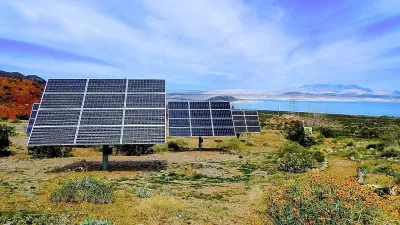The ambitious 6,000-acre project will combine an 800-megawatt solar farm with crop and livestock production.

Ohio state officials have approved a 800-megawatt solar project on 6,000 acres about 25 west of Columbus, the state’s capital. The Oak Run Solar project in Madison County will co-locate 4,400 acres of solar panels and storage with production of sheep and crops, a practice called agrivoltaics, reports the Columbus Dispatch. At a cost of $1 billion, it will be the largest project of its kind in the country, and produce enough electricity to power 170,000 homes and $8.2 million in annual tax revenue.
The Ohio Siting Board approved the project, which will be built on land partially owned by Bill Gates, though it was opposed by local officials, who said the project doubles the amount of prime farmland in the county that will be taken out of production because of solar uses. It’s a concern the practice of agrivoltaics seeks to mitigate by planting crops along the edges of solar fields and allowing livestock to graze between the panels. “In the first year of operation, Oak Run must graze at least 1,000 sheep and grow crops on 2,000 acres. Within eight years of operation, at least 70% of the farmable project area, or at least 4,000 acres, must include agrivoltaics,” reports Mark Williams for the Dispatch.
The development company, Savion, says construction could begin in 2025.
FULL STORY: Mega Madison County solar farm with Bill Gates connection wins Ohio approva

Americans May Be Stuck — But Why?
Americans are moving a lot less than they once did, and that is a problem. While Yoni Applebaum, in his highly-publicized article Stuck, gets the reasons badly wrong, it's still important to ask: why are we moving so much less than before?

Using Old Oil and Gas Wells for Green Energy Storage
Penn State researchers have found that repurposing abandoned oil and gas wells for geothermal-assisted compressed-air energy storage can boost efficiency, reduce environmental risks, and support clean energy and job transitions.

Placekeeping: Setting a New Precedent for City Planners
How a preservation-based approach to redevelopment and urban design can prevent displacement and honor legacy communities.

Colorado Lawmakers Move to Protect BRT Funding
In the face of potential federal funding cuts, CDOT leaders reasserted their commitment to planned bus rapid transit projects.

Safe Streets Funding in Jeopardy
The Trump administration is specifically targeting bike infrastructure and other road safety projects in its funding cuts.

Six Reasons Why Housing Is a Human Right
Is housing a human right? A law professor shares six reasons why it should be, from its role in protecting other rights to global recognition and U.S. legal traditions. As public support grows, could housing be the next right written into law?
Urban Design for Planners 1: Software Tools
This six-course series explores essential urban design concepts using open source software and equips planners with the tools they need to participate fully in the urban design process.
Planning for Universal Design
Learn the tools for implementing Universal Design in planning regulations.
Heyer Gruel & Associates PA
City of Moreno Valley
Institute for Housing and Urban Development Studies (IHS)
City of Grandview
Harvard GSD Executive Education
Salt Lake City
NYU Wagner Graduate School of Public Service
City of Cambridge, Maryland





























